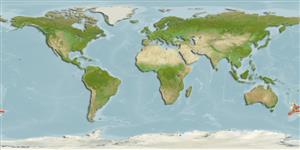Malacostraca |
Decapoda |
Nephropidae
Environment: milieu / climate zone / djupintervall / distribution range
Ekologi
; djupintervall 140 - 640 m (Ref. 4). Temperate; 6°C - 14°C (Ref. 128678), preferred 14°C (Ref. 107945); 33°S - 48°S, 166°E - 173°W (Ref. 4)
Indo-west Pacific: New Zealand and Kermadec Island.
Length at first maturity / Size / Weight / Age
Könsmognad: Lm 3.4 range ? - ? cm Max length : 25.0 cm TL hane/ej könsbestämd; (Ref. 4); common length : 15.5 cm TL hane/ej könsbestämd; (Ref. 4)
It has a total body length of 25 cm, mostly between 13 and 18 cm (Ref. 4). Prefers mud or sandy mud substrates that are firm enough for burrowing (Refs. 4, 106910) (Ref. 4).
Members of the order Decapoda are mostly gonochoric. Mating behavior: Precopulatory courtship ritual is common (through olfactory and tactile cues); usually indirect sperm transfer.
Holthuis, L.B. 1991 FAO Species Catalogue. Vol. 13. Marine lobsters of the world. An annotated and illustrated catalogue of species of interest to fisheries known to date. FAO Fish. Synop. 125(13):292p. Rome: FAO. (Ref. 4)
IUCN Red List Status
(Ref. 130435: Version 2025-1)
CITES status (Ref. 108899)
Not Evaluated
Not Evaluated
Threat to humans
Human uses
Fiskeri: kommersiell
FAO - fiskeri: landings | FishSource | Sea Around Us
Verktyg
Ytterligare information
Trophic EcologyFood items (preys)
Födosammansättning
Födointag
Predatorer
Population dynamicsTillväxtMax. ages / sizesLength-weight rel.Length-length rel.Length-frequenciesMass conversionAbundans PhysiologySyreförbrukning
Human RelatedStamps, coins, misc.
Internet-källor
Estimates based on models
Preferred temperature
(Ref.
115969): 8.6 - 13.4, mean 10.9 (based on 30 cells).
Fishing Vulnerability
Low vulnerability (15 of 100).
Climate Vulnerability
Moderate vulnerability (37 of 100).
Nutrients : Calcium = 109 [35, 184] mg/100g; Iron = 1.59 [1.21, 1.97] mg/100g; Protein = 20.2 [19.2, 21.3] %; Omega3 = 0.285 [0.185, 0.386] g/100g; Selenium = 48.3 [-31.7, 128.3] μg/100g; VitaminA = 0 μg/100g; Zinc = 1.79 [1.17, 2.40] mg/100g (wet weight); based on
nutrient studies.
